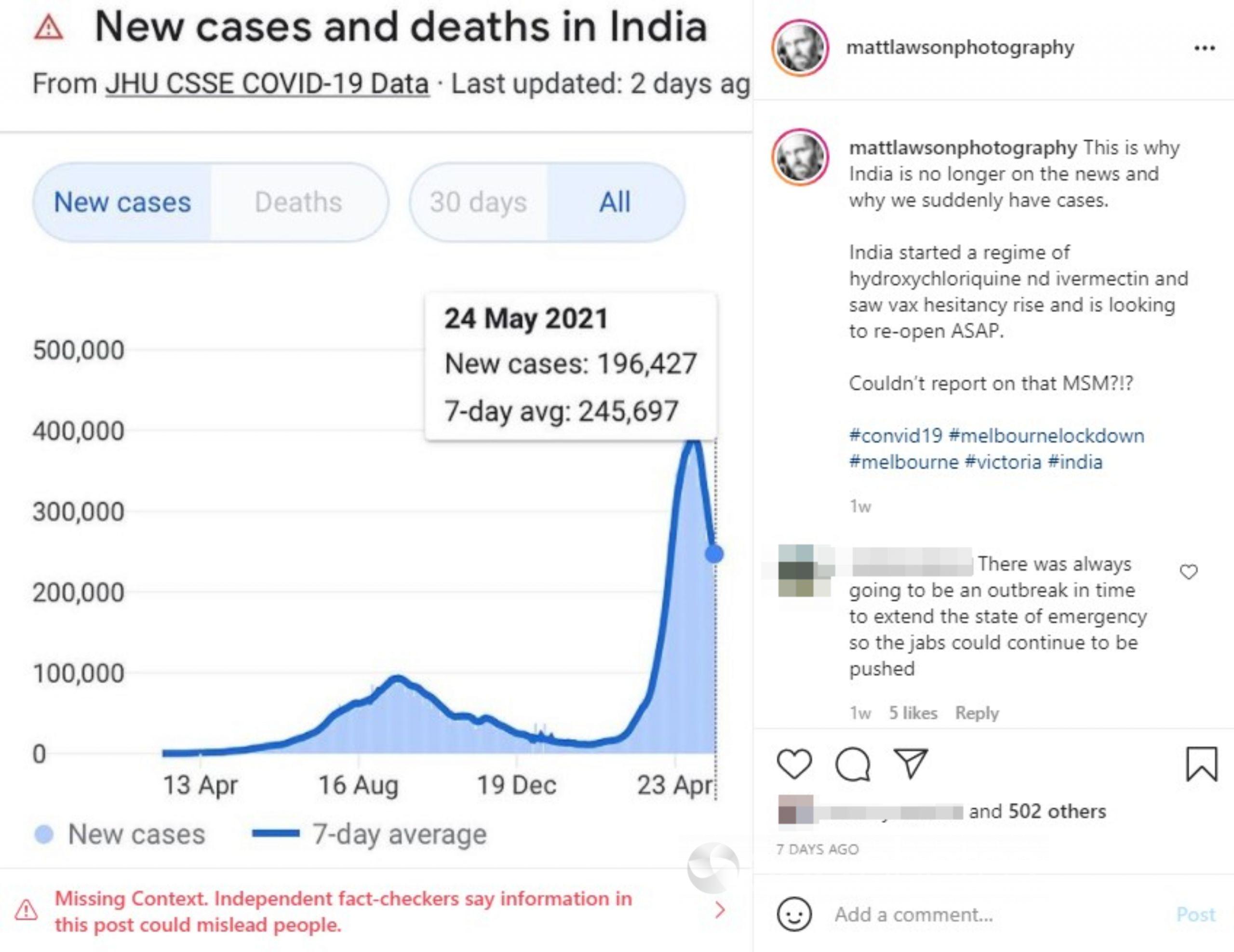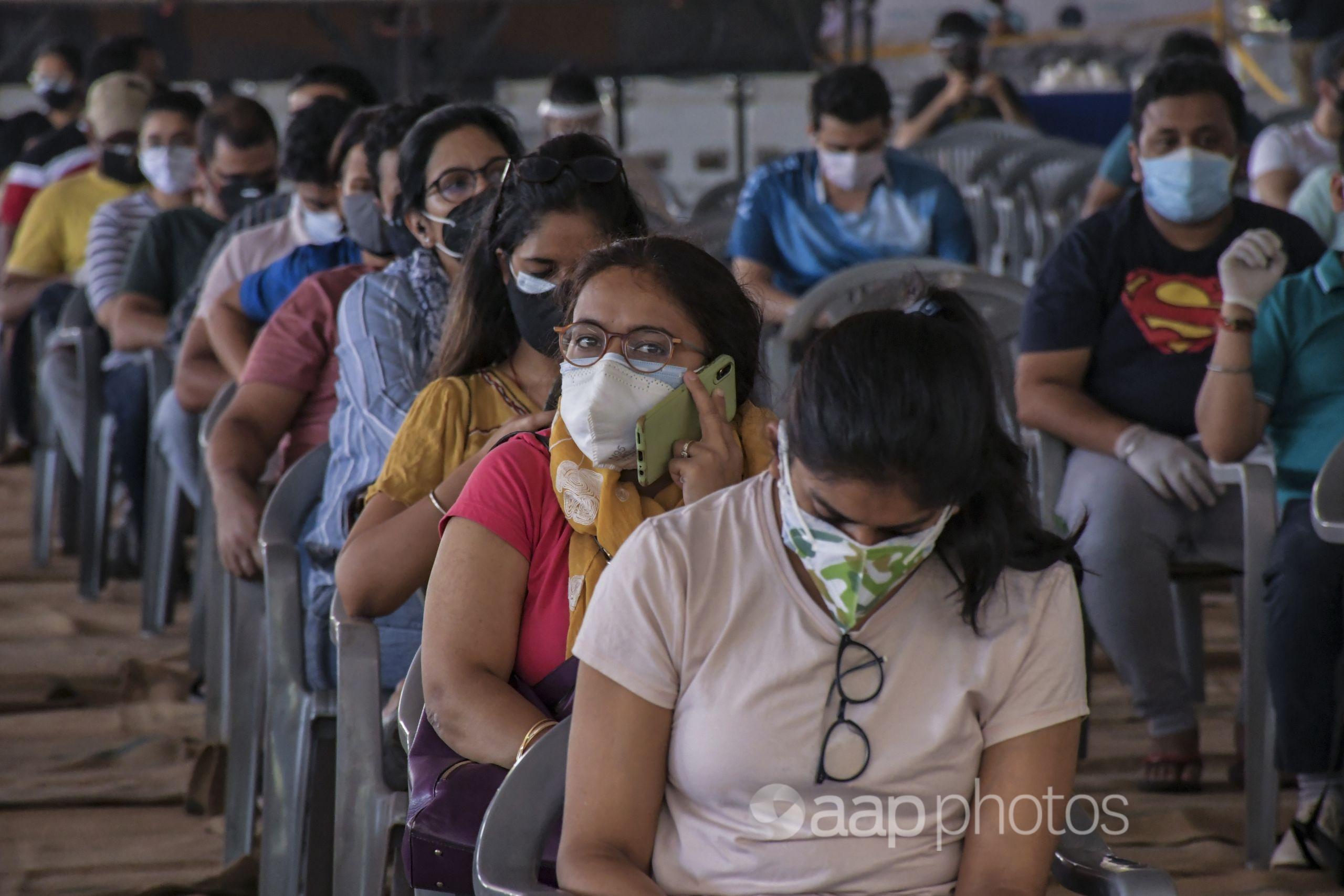The Statement
An Instagram post by an Australian user suggests that falling cases of COVID-19 in India are due to a regime of hydroxychloroquine and ivermectin being used as treatments.
The post features a graph of Indian COVID-19 cases and deaths credited to Johns Hopkins University. The chart shows a steep rise in cases before a peak and gradual decline to 24 May.
“This is why India is no longer on the news and why we (in Australia) suddenly have cases,” the post claims. “India started a regime of hydroxychloriquine (sic) nd ivermectin and saw vax hesitancy rise and is looking to re-open ASAP.”
At the time of publication, the post had been liked nearly 500 times and shared more than 14,000 times.

The Analysis
While India’s COVID-19 cases have declined from their peak in early May, there is no evidence a “regime” of the drugs hydroxychloroquine and ivermectin are responsible for the fall.
The same period also reflects a time when strict regional health controls were in place in many parts of the country and tens of millions of vaccine doses were rolled out to combat a deadly second wave of the virus.
India’s COVID-19 case count began to rise sharply in mid-March, eventually reaching a peak of more than 400,000 daily diagnoses in early May, according to Johns Hopkins University data.
Since the peak, cases have declined; the same figures put the new case count at 114,000 on June 5. By that date, the number of active cases in the country was around 40 per cent of the peak figure, local media reported.
The true case numbers in India are suspected to be considerably greater than reported due to limited testing, according to analysis by The Associated Press.
The rise in cases led to many states introducing curbs on economic activity and public movement, although the national government shied away from introducing a country-wide lockdown. For example, Delhi’s regional government announced it would extend its curfew on non-essential movement until June 14.
Meanwhile, the drop in COVID-19 cases also coincides with the acceleration of the country’s vaccination program. According to Our World in Data, more than 140 million people had received at least one dose of a COVID-19 vaccine by mid-May. The figure represents around 10 per cent of the population.
The post’s claim regarding India beginning a “regime” of hydroxychloroquine and ivermectin treatments appears to relate to updated guidelines for mild and asymptomatic cases of COVID-19 issued by the Ministry of Health and Family Welfare on April 28.
Both drugs have been frequently touted as possible COVID-19 treatments, however international health agencies (see here, here, here and here) have advised against their use citing a lack of evidence of their efficacy as well as potential side-effects.
Nevertheless, the Indian guidelines recommended close contacts of mild or asymptomatic cases take hydroxychloroquine, an anti-rheumatic drug, while people in home isolation with similar cases were told to “consider” taking ivermectin, commonly used in humans and animals to treat disease caused by parasites.
The advice was included alongside various other guidelines, such as twice-daily “warm water gargles” and the wearing of a triple-layer medical mask.
The health ministry’s clinical treatment guidelines, issued on 24 May, also said doctors should “consider” giving either ivermectin or hydroxychloroquine to patients with mild cases of COVID-19.
However, the guidelines did not represent a major shift in the official advice except for the addition of ivermectin. India’s superseded guidelines, issued on July 3, 2020, also said hydroxychloroquine could be used for for both mild and moderate cases.
The Indian Council of Medical Research had advised the use of the drug since as early as April that year, despite criticism from some experts that the treatment was unproven in its effectiveness and could lead to “preventable morbidity and mortality”. By February 2021, the government had distributed more than 100 million hydroxychloroquine pills.
Researchers from the George Institute for Global Health, which has offices in Australia and India, wrote in an article published by The Lancet on June 2 that ivermectin and hydroxycloroquine were amongst several drugs that were included in a “typical prescription” for COVID-19 in India.
Carlos Chaccour, a health researcher at The Barcelona Institute of Global Health, has written extensively on ivermectin and urged caution on its use to fight COVID-19.
“These kind of ‘ecologic analyses’ (in the Instagram post) have been broadly used to support ivermectin,” he told AAP FactCheck in an email.
“The truth is that many other states/countries NOT deploying ivermectin have experienced a sharp descent in transmission, normally because of lockdown, awareness or other non-pharmacological measures.”
Dr Chaccour wrote that ivermectin has “been in the spotlight as an example of the risks of rushed and scientifically unfounded debates in the response to crises” such as COVID-19.
Professor Catherine Bennett, the chair of epidemiology at Deakin University, wrote in February that the evidence on hydroxychloroquine and ivermectin was lacking. When contacted by AAP FactCheck, she said her opinion remained the same.
“There has been no change re: evidence, except even more trial results published that indicate neither make a difference in moderating disease outcomes in those with COVID-19,” she said in an email.
Prof Bennett said many factors came into play to reduce case numbers in a country, but it was “nonsensical” for such changes to be attributed to the two drugs.
Steven Tong, an infectious diseases physician and associate professor at the Doherty Institute for Infection and Immunity, agreed, telling AAP FactCheck via email: “There is no evidence to support the claim that hydroxychloroquine and ivermectin would lead to reduced case numbers. All the trials I am aware of have not demonstrated any beneficial effect of these two agents.”
The post’s claims follow a May 17 article by the far-right website, The Gateway Pundit, which has been fact-checked as a frequent source of misinformation, which stated: “Coronavirus cases are plummeting in India thanks to new rules that promote Ivermectin and hydroxychloroquine to its massive population.”
However, fact-checkers Health Feedback noted India’s reproduction rate (R rate) – a measure of the number of new COVID-19 infections generated by each case – was already falling prior to the health ministry’s new guidance.
Similar claims have previously been debunked here, here and here.
The Verdict
There is no evidence that new guidance on the use of ivermectin and hydroxychloroquine led to a reduction in COVID-19 cases in India. In fact, hydroxychloroquine was reported to be in widespread use well prior to the country’s second-wave outbreak.
Experts told AAP FactCheck the treatments had not been shown to be effective in combating the coronavirus. India’s reduction in cases also coincides with other public-health measures, such as the vaccine rollout and statewide lockdowns.
False – Content that has no basis in fact.
AAP FactCheck is an accredited member of the International Fact-Checking Network. To keep up with our latest fact checks, follow us on Facebook and Twitter.
All information, text and images included on the AAP Websites is for personal use only and may not be re-written, copied, re-sold or re-distributed, framed, linked, shared onto social media or otherwise used whether for compensation of any kind or not, unless you have the prior written permission of AAP. For more information, please refer to our standard terms and conditions.


















